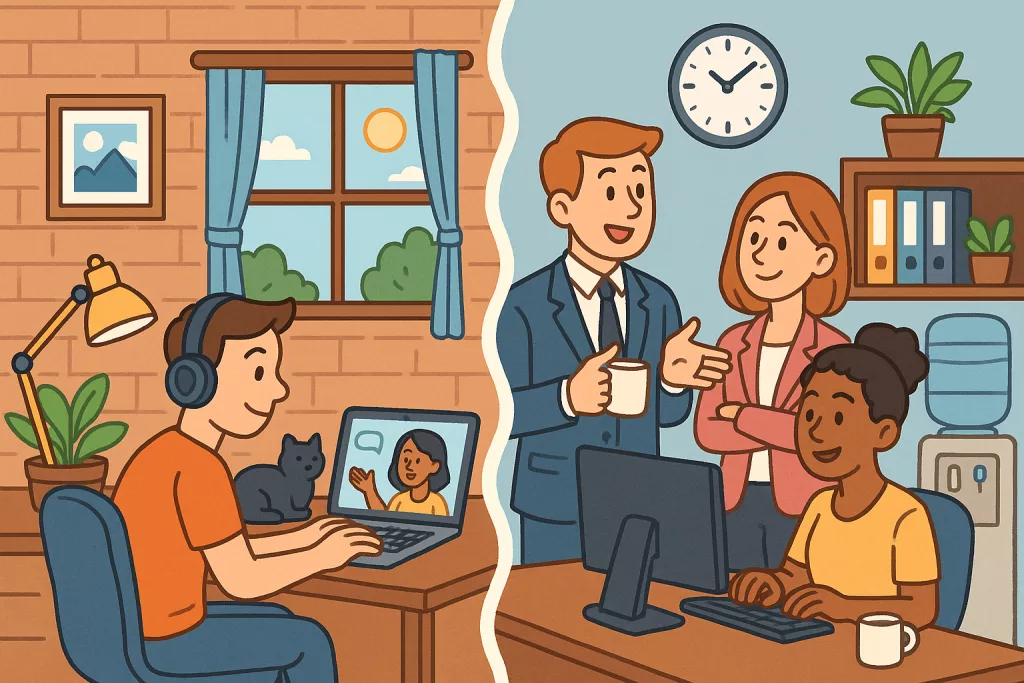Let’s be real: remote work changing office culture has gone way beyond “Zoom from your PJs.” We’re now living through a full-blown culture shake-up. Offices used to be sanctuaries for impromptu chats and water-cooler gossip. Now? They’re becoming collaboration hubs, AI-enhanced zones, or occasionally ghost towns users only visit for specific sparks of inspiration.
This post is your friendly, no-fluff guide to what’s actually happening right now: the rise of blended workplaces, AI integration, shifting social vibes, and the real trade-offs of the new normal.

1. Hybrid Is So 2020. Welcome to the Blended Era.
What’s “blended work”?
It’s not hybrid (two days home, three days the office). It’s a whole new ballgame where AI teammates, flexible locations, and dynamic schedules merge into one workplace ecosystem.
According to a 2025 academic paper, hybrid is already obsolete. What’s emerging now is blended: human and AI collaboration, virtual presence, and outcome‑based work, not attendance
Why it matters:
- Traditional in-person vs. remote debates become pointless when your “coworker” is half‑AI.
- Office culture evolves from “who you know at the water cooler” to “how well humans and AI riff off each other.”
2. Flexible Models That Actually Work (and Save Money)
Remote work changing office culture isn’t just about Zoom fatigue—it’s also about giving companies a chance to reinvent space, autonomy, and outcomes.
- In 2025, about 22% of U.S. jobs are remote, and 83% of employees globally prefer hybrid models—so flexibility is now table stakes.
- The U.S. Government Accountability Office (GAO) said five-day office mandates are outdated, noting that remote/hybrid setups boost retention, cut costs, and improve productivity—like by 12% where metrics allow.
- Australia-level data shows hybrid work helps avoid thousands in commuting costs—enhancing real-life budgets and morale
3. Culture Reset: From Casual Chats to Intentional Design
Remote work changing office culture means you can no longer rely on accidental hallway convos to build trust—intentional design is the new vibe.
Challenges:
- Less spontaneous face-to-face interaction can harm psychological safety—teams feel disconnected or less safe to speak up.
- Remote work also struggles with informal social bonding. “Zoom fatigue” and awkward video norms can kill the vibe.
What companies are doing:
- Activity-Based Working (ABW): design offices for different modes—deep work, impromptu collab, quiet zones—so culture isn’t tied to one desk.
- Cohort days: teams sync their in‑office days for spontaneous chats and brainstorms.
- Intentional social rituals: virtual coffee chats, 1:1 buddy systems, digital socials—they keep cohesion alive in remote teams
4. Pushback: RTO is Backlash—Maybe Expect a Revolt
Some companies are trying to drag employees back into the office full-time—and employees aren’t having it.
- In the UK, 48% of firms now favor ending hybrid, up from 27% in 2023—but that push is already sparking blowback
- One in ten businesses admitted losing employees over return-to-office mandates.
- In the U.S., the rise in mothers leaving the workforce is linked to inflexible RTO policies—further proof mandates ignore real-life needs.
- Microsoft is considering a stricter RTO policy—minimum 3 days/week in office starting early 2026—but nothing is set in stone yet.
Bottom line? Hard mandates are talent repellents. Not great for culture, retention, or your mom’s sanity.
5. The Office-as-Hub, Not Home Base
Rather than regular attendance, offices now act as on‑demand culture studios—places to connect, create, and recharge.
- Office spaces are being reimagined as zones for collaboration, inspiration, or just human contact—not mandatory cubicles.
- Practices like hoteling (booking desks as needed) reduce real estate costs and make the office feel more like a dynamic space than everyone’s assigned cage.
- When people do show up, it matters—and it’s about structured, meaningful face time.
6. The AI Crew: Colleagues with Code
AI isn’t just automating tasks—it’s reshaping how teams think, work, and interact.
- AI tools now draft reports, help with brainstorming, automate meeting notes—basically becoming teammates.
- Team culture is no longer just a human thing—it now includes AI behavior, transparency, and how we assign credit.
- Trust and clarity matter: who “owns” ideas, how AI decisions are audited—you gotta design culture around algorithmic teammates.
7. What You Can Do
Here’s the chill, practical guide—no buzzwords, just stuff that works:
- Be clear about what makes the office valuable
- Use surveys or casual check-ins to understand why people want to come in—social, focus, hardware—and design office time around that.
- Design flexible policies with structure
- Allow varied schedules, but encourage overlapping days for collaboration. Think: “Come in when your team is here.”
- Create human (and AI) connection routines
- Virtual coffees, check-in rituals, feedback loops, buddy systems—and maybe “AI feedback loops” so your team trusts the bots.
- Redefine productivity around outcomes—not hours
- Use performance metrics that focus on impact and results, not who sat at a desk or turned cameras on.
- Design physical spaces as dynamic hubs
- Think hot‑desks, casual lounges, team zones—not rows of assigned desks. Delegate physical office space based on activity rather than attendance.
- Cultivate culture beyond presence
- Shared digital rituals, recognition channels, and including remote folks in small moments keeps people from feeling like extras.
Final Thoughts
Yep, remote work changing office culture is literally rewriting how we work, connect, and show up. The blend of AI teammates, flexible space design, and outcome-based expectations is flipping the script on traditional culture. Your office isn’t dead—it just evolved. Your “coworkers” are partly code. And your power move? Designing a culture that works for humans and algorithms.
References
- Nabirye, Kato H. “The Impact of Remote Work on Organizational Culture.” EE Journals (via ResearchGate), 12 February 2025. researchgate.net
- Tahlyan, Divyakant, Hani Mahmassani, Amanda Stathopoulos, Maher Said, Susan Shaheen, Joan Walker, and Breton Johnson. “In-Person, Hybrid or Remote? Employers’ Perspectives on the Future of Work Post-Pandemic.” arXiv, 28 February 2024. arxiv.org
- VoxEU Column. “Remote Work Matters, but Culture Is the Elephant in the Room.” VoxEU, 22 January 2025. . cepr.org






